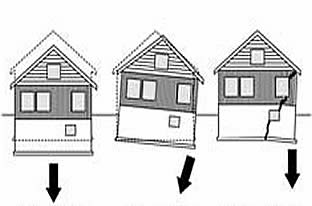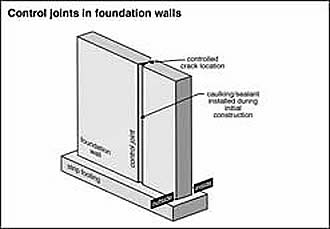'THIS HOUSE ISN'T GOING ANYWHERE.' OR IS IT!
Serious structural problems in houses
are not very common, but when they occur they are never cheap to fix. Some
can't be fixed at all. This report won't turn you into a home inspector, but
it will give you some of the common indicators.
UNEVEN FLOORS
Uneven floors are typical, particularly in older homes. Here is a trick to help distinguish between a typical home with character and a structural problem. If the floor sags to the middle of the home, it's probably just a charming old home. Houses are like people, they sag in the middle when they get older. On the other hand, if the floor slopes towards an outside wall, there is a good chance that the house has a significant structural problems.

LEANING HOUSE
No house is perfect but this is one area where you should be very careful. Take a look at the house from across the street. It is easy to miss something major by standing too close. If the house appears to be leaning, there may be a structural problem. It may help to line up a front corner of the house with the back corner of an adjacent house just for reference. The corners should be parallel. If there is a lean that is detectable by eye, don't take any chances, get it checked out.

HORIZONTAL FOUNDATION CRACKS ARE BAD
It is not uncommon to find cracks in the foundation. This goes for new houses as well as old ones. While there is a great deal of engineering that goes into "reading" these cracks, there is one rule that you should never forget: Horizontal cracks are a problem. Of course, not all vertical cracks are acceptable, but they are generally not as serious as a horizontal crack.

HARMLESS CRACKS
Shrinkage cracks in a new house: Most new foundations will develop small vertical cracks. These cracks are a result of the concrete shrinking as it cures. These cracks are about 1/8 inch wide or less. They don't affect the structure. The only concern is leakage. If you see small cracks in a new foundation, don't panic. In fact, in a new home, some builders will pre-crack the foundation and fill the crack with flexible material.
PLASTER CRACKS
Few things are more misunderstood than plaster cracks on the inside of the house.
The following crack types are not generally related to structural movement:
- a small crack (less than ¼ inch) that follows the corner of the room where two walls meet
- small cracks that extend up from the upper corner of a door opening
The following cracks may be related to structural movement:
- large cracks (larger than ¼ inch in width)
- cracks that run diagonally across the wall
- cracks on the interior finish that are in the same vicinity as cracks on the exterior of the house
Illustrations are from the Carson Dunlop Illustrated Home.
<< Back to Technical Library |